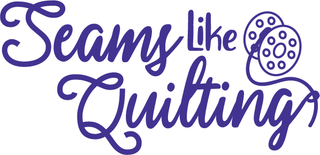Flannel is warm, cozy, and soft. Perfect for curling up by the fire with a hot apple cider on a cold winter’s night. Perfect for the back of a quilt.
Or is it? If you’ve ever backed a quilt weight cotton quilt top with flannel, you may have already discovered that flannel has some…quirks. Flannel shrinks at a higher rate than quilt weight cotton and can get into arguments with some sewing machines.
Not all flannel is the same. High quality flannel is double-sided, washes and wears well, and frays less than cheaper versions of cotton flannel. Lower quality flannels also have a low thread count and can pill easily after a single wash. Be sure to accommodate shrinkage, stretching and fraying when you purchase flannel, especially if you skip your local quilt shop (*gasp*) to purchase a less expensive flannel from a box store or use inexpensive flannel sheets for a quilt back. While these low cost alternatives can save us dollars up front, we need to prep them a bit more to make sure we don’t have problems while we’re quilting. There are specific steps to take with any flannel to have a consistently successful outcome.
- Pre-wash. Even if you don’t pre-wash anything else. Flannel shrinks at a higher rate, which means if used on a quilt back before it’s washed, it will cause substantial puckering after a trip through the laundry. And even if you prefer that look, it can create stress on your stitches and cause breakage that will later unravel. You will still get the puckering over time.
- Cut on grain. Or use fray check. The fraying for flannel can be substantial, especially if you’re cutting on the bias. For quilt backs, it may not be as essential to check the fraying on the edges, but for piecing, this step is a must. Quick piecing methods for HSTs or flying geese rely on bias cuts and can be very frustrating to execute with a rapidly fraying fabric.
- Use a new needle. Nothing special - an 80/12 or 90/14 will work, but a dull needle will be extremely frustrating with flannel. Save the snags and snapped threads and change the needle before you begin. Sharp scissors and/or rotary blade will help out as well.
- Rip carefully. A seam ripper can more easily puncture a low thread count fabric and leave a tear right where your seam should be.
- Use a walking foot. Flannel stretches.
- Clean your machine after. All that fraying we were talking about? Yeah, that means lint too.
- Cuddle your quilt!
It may seem like quilting with flannel is nothing but a pain, but with a little preparation, that soft cuddle quilt back can be yours. And now, with manufacturers making so many amazing prints in flannel, there are more high-quality flannel choices available than ever before. In fact, Seams Like Quilting has a ton of flannel options in solids and prints for your quilting enjoyment.

